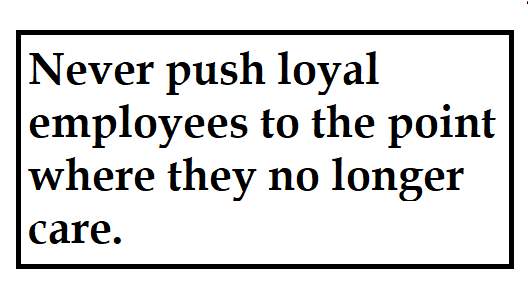Employees are your Most Valuable Asset!
Employees are your most valuable resource. Yet many companies ignore and treat their employees poorly. Our system has fallen into a self-reinforcing command loop construct as follows: Increase shareholder value at all costs without regard for the human factor. Sadly, if you do not cure the cancer in the root of the tree, not only.

Employees are your most valuable resource. Yet many companies ignore and treat their employees poorly. Our system has fallen into a self-reinforcing command loop construct as follows: Increase shareholder value at all costs without regard for the human factor. Sadly, if you do not cure the cancer in the root of the tree, not only with the branches and leaves die; but so will the the tree. Unhappy employees cost companies billions of dollars each year in lost revenues, settlements and other damages. The loss of revenue can send even established companies into financial distress, with some even filing for bankruptcy.
Financial Losses can result from:
Decreased Productivity. According to research conducted by Gallup, disengaged employees cost companies $450-to-$550 billion in lost productivity each year as a result of poor performance and high absenteeism.
Put your staff first, your customers second & your shareholders third ~Richard Branson
Employee Negligence: When employees are put first, they feel a sense of ownership to the business. Such employees will always take the initiative to solve problems before they get worse. On the other hand, an unhappy employee will just move along and not care as an issue escalates. It is also common for dissatisfied employees to neglect to complete tasks or make mistakes. This leads to poor quality control standards, unsafe products and dangers to consumers. Cases of serious injury or death, caused by company negligence often results in hefty settlements being paid out to those affected.
Tarnished Reputation: Employees interact with customers and could say anything negative about the company’s culture, products and services. The actions of one individual can bring down a company or uplift it.In an age of social media, individual employee actions can have dire effects on an organization. Video accounts of poor customer service experienced by a consumer can go viral on Facebook with similar hashtags on Twitter calling for a boycott of the company. This story can then be picked up by mainstream news bringing negative press resulting in companies having to settle lawsuits.
Employees are the branches of the tree that makes a company grow. Research has found an economic link between employee satisfaction and company financial performance. Employees who genuinely like coming to work every day may have a positive impact on a company’s stock performance. A happy workplace culture does translate into better stock returns. Happy Employees = Happy Customers = Happy Shareholders.
Take good care of your employees, and they’ll take good care of your customers, and the customers will come back. ~J.W. Marriott
Employees are your best brand ambassadors. Your brand position is determined by the customer’s experience. The experience is delivered by your front line employees. If you take care of your employees, they will take care of the business. Your employees know your customers best. They use your internal tools and systems every day. They have the answers on how to improve customer service and your products. They have the solutions on how to improve systems which can save money by driving efficiencies.
Employees are the backbone of any organization. In order to remain strong in an industry, employees have to be kept happy. Happy employees are always willing to do more, they will go to great lengths to help the company grow. Charity begins at home. If you want to get the best out of your employees – Put them first.
Leading the Workforce of the Future provides concrete advice and best practices on how to engage and retain top talent. It addresses several areas to focus on to future proof yourself and your business. The future is no longer some far-off destination; it is already here. Don’t be caught off guard!
Thank You.
Dg_woks










